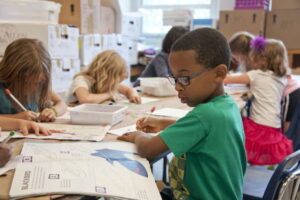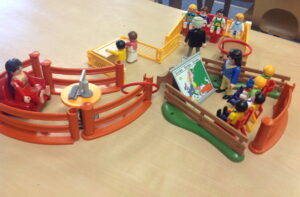Authored by:

Catherine Gripton
Catherine Gripton is Assistant Professor in the School of Education, University of Nottingham. Her interests include: early years practice and pedagogy, children's perspectives in education and early childhood mathematics.
The impact of ‘ability-informed’ practices upon individual children is difficult to predict and raises questions about their use.
‘Ability’ in the primary school
‘Ability’ in education has been long debated and heavily researched. Much of the focus has been on ‘ability’ grouping which has proved somewhat of an educational hot potato including the ‘great debate’ about selective schooling. Whilst the practice is contentious, the research evidence is pretty conclusive. Ability grouping has no overall positive impact on attainment and can have negative consequences for children in social and emotional outcomes. The null overall academic impact is not consistent across the ‘ability’ scale so children in higher groups are typically slightly advantaged whilst children in lower groups are disadvantaged according to attainment measures.
‘Ability’ grouping can be streaming (one grouping for all subjects), setting (different groupings for specific subjects) and within-class (small ‘ability’ groups in the same class). The use of setting (secondary and some primary) and within-class grouping (primary) is commonplace in England’s schools. There is support for schools to move away from setting in secondary schools including UCL’s dos and don’ts checklist. Recent adaptations due to coronavirus also raise the possibility of a more mixed attainment grouping, as indicated by Tom Francome in his recent article on mathematics teaching.

Teachers and ‘ability’
It is a challenging landscape for primary teachers under pressure to meet attainment targets and to meet children’s perceived needs within a culture of differentiation whereby provision of different tasks and ‘ability’ grouping have been key strategies over time. Indeed, ‘ability’ is ingrained into school accountability and assessment tracking systems where ‘ability grouping’ and other ‘ability-informed’ approaches (such as levelled reading schemes) might be perceived as a natural extension of this.
For individual primary teachers, there is a concern that such practices might have a ‘labelling’ effect on children (Marks 2016), potentially limiting performance and shaping self-identity resulting in a tension within classroom practice. Teachers often express unease, deeming ‘ability’ grouping as ‘a necessary evil’ (Bradbury & Roberts-Holmes 2017).
Children’s experiences in two case study schools
In research with 5-7 year olds in two schools, I found children’s lived experiences of ‘ability’ to be highly individually and significantly personal. The meaning the children made of their experiences of ‘ability’ were much more than the groups they were placed in or the names these were given. The children’s lived experiences of ‘ability’ were shaped by a combination of factors. For each child, it depended on what they were noticing and attentive to within their classroom. Some children focussed more on the physical environment, classroom systems or curriculum. Others focussed more on the work set (classroom tasks), classroom discipline or opportunities to play and make choices. Aspects of social learning including relationships with other children or relationships with adults in the classroom were particularly important for some children. Additionally, some children had a much wider awareness than others with some paying attention to the whole class throughout the day whilst others focussed on a small consistent number of children. The interplay between these factors provided a unique experience of ‘ability’ for each child in the study.
Unique experiences of ‘ability’
For example: Freya, a six year old, was quite dissatisfied with her group placement and had even challenged the teacher on it. She was keenly focussed on her friendships and noticed what her friends, who were in different ‘ability’ groups to her, were doing. This gave her a real sense that each group were doing ‘easier’ or ‘harder’ work and thus an understanding of the hierarchy at play. She had a strong preference for social learning experiences but did not have close relationships with the children in her group, so seemed frustrated at not being able to learn in the way that she wanted to.

One child’s construction of their experience
While Georgia, a five year old, yearned for a quiet and orderly space to learn in the classroom. She expressed feeling crowded in her groups which were all larger, middle attainment groups. This in turn contrasted with Harry’s lived experience who, in the same groups as Georgia, enjoyed the variety and stimulation and seemed to thrive off it.
With children’s lived experiences of ‘ability’ being so individual, we cannot assume that all children ‘at the same level’ or ‘in the same group’ experience this in similar ways. What matters to children is what they pay attention to – what is important to them. Some aspects of classroom life are incredibly powerful for an individual child and others pass them by almost unnoticed.
This means that a child, such as Christopher, can be in a lower group but not realise this and so does not experience the commonly associated negative outcomes. For him, his friends were incredibly important, and he was keenly aware of what they did and where they sat in the classroom. His awareness focussed only on these children who were in the same group as him and he enjoyed the comfort of this group. Hal, on the other hand, was in this same group as Christopher but had a wider scope of awareness, noticing all children in the class. He made sense of the different tasks given to different children and the transitions in the school day. These shaped his understanding of his own ‘ability’ and of the nature of learning more generally and he regarded himself as innately not as clever as others. His experience of ‘ability’ groups was one of busyness with much moving of seating and changing of activities, lamenting the lack of time for play in his classroom experiences. Hal and Christopher were in the same groups with the same children and the same adults but constructed and internalised these experiences in completely different ways.
‘Ability’ in practice
This research study indicates that homogenous ‘ability’ labels might not lead to homogenous experiences of ‘ability’ for children. Anticipating the impact of specific teaching choices upon children in a primary classroom is therefore challenging. The varied experiences of children in my case study classes suggest that a wide range of factors, including friendships, need to be incorporated into decision making about grouping and other practices. Children’s preferences for where they learn in the physical classroom layout is one avenue to explore with children, arising from this study.
Using a range of grouping strategies (not just ‘ability’) and disassociating seating arrangements from ‘ability’ can reduce the permanence or ‘fixed’ understanding of ‘ability’ that some children can form. Additionally, classroom systems and routines might indicate ‘ability’ judgements to some children yet these might be easily adapted to make such judgements less apparent to the children who notice these. Reducing both the subtle and overt use of ‘ability’ labels in classrooms is important but reduction does not go far enough. My findings suggest that even infrequently used strategies should be considered carefully as they can be have a significant impact upon a child. In one of the schools, a teacher used a system of A, B and C level questions in one mathematics lesson. Jasmin, a seven year old in this class, used these letter labels to describe herself and her peers. This one-off teaching approach structured and shaped her conception of ‘ability’ and her self-identity.
Children can, through their insights, reveal the significant impact of practices such as ‘ability grouping. The varied and sometimes substantial impact of ‘ability’ on the children in this study supports the wealth of existing literature that calls for us to challenge the use of ‘ability-informed’ practices in schools.
For further details of the study see: Catherine Gripton (2020): Children’s lived experiences of ‘ability’ in the Key Stage One classroom: life on the ‘tricky table’. Cambridge Journal of Education.
[A .pdf version of this article is available for download here]
Authored by:

Catherine Gripton
Catherine Gripton is Assistant Professor in the School of Education, University of Nottingham. Her interests include: early years practice and pedagogy, children's perspectives in education and early childhood mathematics.
Leave a Reply